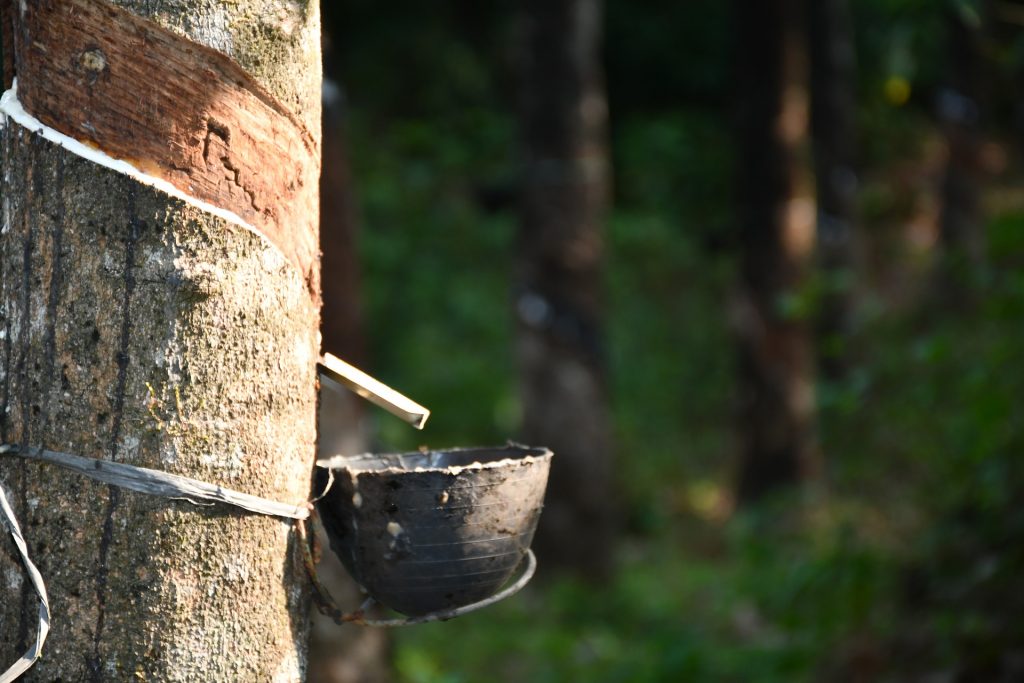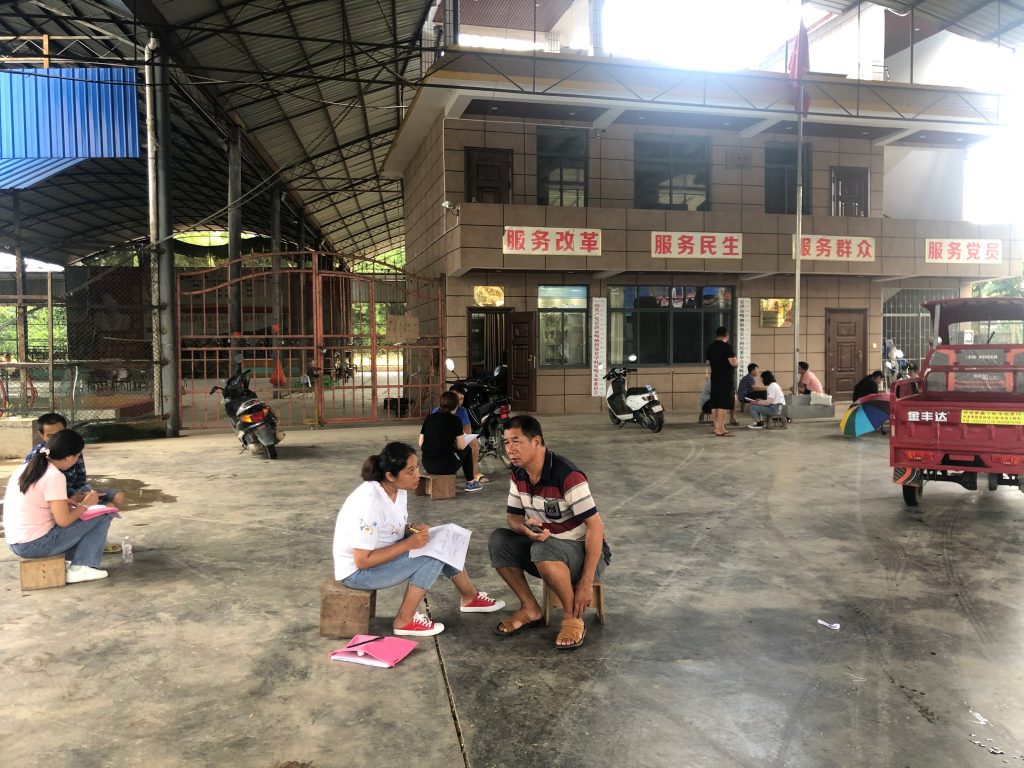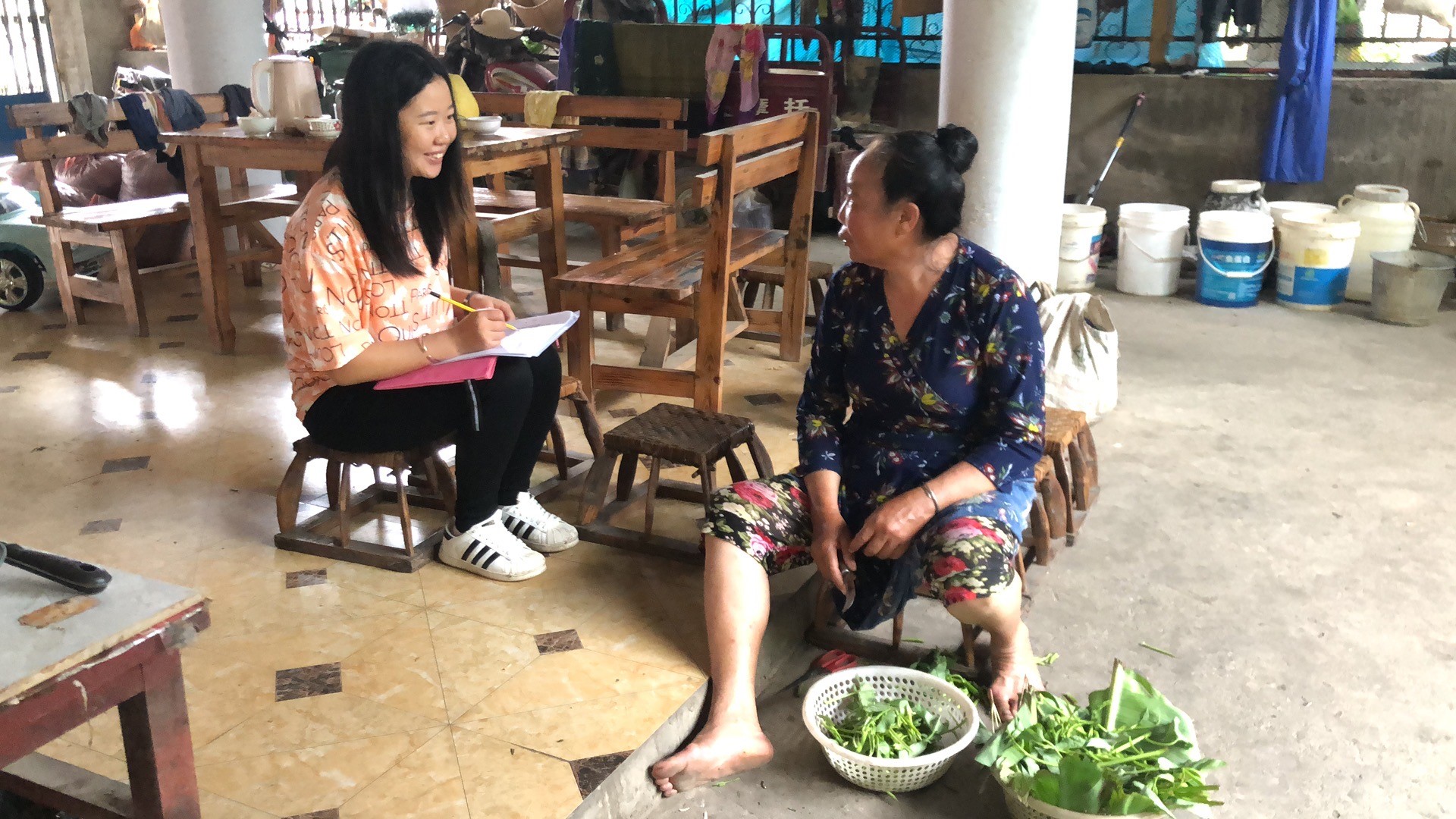by Yufang Su and Austin Smith
Originally posted on 30 Sep 2021 on www.worldagroforestry.org
Rubber expansion and decline have major implications for Chinese farmers, particularly women, and their livelihoods. In this feature, we examine the impact on women in Xishuangbanna, China’s ‘rubber heartland’.
Ever looked at a pair of shoes and wondered where the rubber soles came from? Most people don’t, one of the authors included. Rubber is something we all take for granted.
Rubber comes from milky white liquid called ‘latex’ from the bark of the para rubber tree — Hevea brasiliensis, a species native to rainforests in the Amazon — through an extraction process known as ‘tapping’. Nowadays, 97% of the world’s natural rubber is produced by rubber farms in Southeast Asia.
It’s a strange material. Elastic, strong, pliable, water resistant: a unique combination of so many useful attributes. This versatility enables it to have high utility in domestic and industrial applications and it is found in numerous objects used throughout our daily lives, from car tyres to clothing.
Our lives rely more than ever upon rubber products. Current estimates forecast that the population of the middle class will increase 80% by 2030 to 5.5 billion planetary inhabitants, significantly increasing demand for rubber, not least because the number of vehicles in the world is expected to double by 2050 and there simply are no alternatives to rubber in tyres. If humans are to live sustainably on the planet then we must seriously consider the degree to which the growth and production of rubber interacts with our modern lifestyles.
What’s the story?
Yunnan Province, located in southwestern China, is responsible for over half of China’s total natural rubber production. Three-quarters of Yunnan’s natural rubber is produced in Xishuangbanna Dai Autonomous Prefecture, China’s ‘rubber heartland’ on the border of Myanmar and Lao PDR. This one small prefecture in Yunnan alone supplies one-third of China’s total domestic rubber production. Given its importance not only to local smallholders and regional interests but also to global supply chains, local people, forests, natural resources, water and more, rubber production in Xishuangbanna has been a studied landscape by international and Chinese scientists for many years.
Rubber plantations were first established in the area in the 1950s during the Korean War. At the time, rubber was elevated to the status of strategic, industrial product to meet wartime manufacturing needs. China’s military vehicles and supplies required rubber latex, leading to the local saying that ‘rubber is as valuable as gold’. Later, economic blockades and embargoes against China forced central government policymakers to strongly promote the domestic development of natural rubber production. These efforts paid off: soaring rubber latex prices and rural land system reform led to joint action by private- and public-sector groups in Xishuangbanna, such as subsidizing smallholding rubber farmers, establishing large-scale monocultural rubber plantations, developing temperature-resistant tree varieties, and offering advanced training for agrotechnicians. As more rubber products entered the global marketplace in the 1980s and economic blockades and embargoes slackened, demand continued to grow. China’s emergent domestic car industry also fuelled a rubber boom in the 1990s and early in the new millennium, as higher-salaried individuals began to adopt middle-class lifestyles, including private-vehicle ownership.
Lucrative rubber prices have been a major source of revenue for local governments and farmers. In 2008, rubber contributed to nearly one-third of total revenues for the People’s Government of Xishuangbanna Prefecture and half of household incomes of farmers. Strong partnerships between private and public enterprises have promoted the aggressive expansion of rubber plantations. Farmers have enjoyed consistently rising household incomes for years and rubber cultivation has been crucial for poverty alleviation in the region. Indeed, the economic model used for rubber has been praised across China for meeting local needs and lifting rural communities out of poverty.

Image: Pixabay
Emerging issues
However, this newfound economic prosperity also introduced its share of challenges, drawing the attention of conservation ecologists and economists who sought to understand the multifaceted and interconnected issues of Xishuangbanna. The health of the Mekong River Region — a global biodiversity hotspot teeming with a rich array of animal and plant life unseen elsewhere else on the planet — is now seriously imperilled. The widespread felling of trees has caused a suite of negative effects on the land, from loss of biodiversity through soil hardening and erosion to degradation. As rubber plantations have continued to expand into intact forest ecosystems, natural forest coverage has declined from 70% in the 1970s to 50% in the 2000s. However, from 2014 to 2020, a slight increase in natural forest cover occurred for the first time as rubber plantation area decreased, indicating a mild reversal of the multi-decade trend of decreasing forest cover and increasing rubber-plantation land. This land-use change has led to flattening species’ diversity as well as accelerating rates of species’ endangerment. Sediment runoff and pesticide-associated pollution are also increasing problems in the area.
In addition to environmental concerns, in 2011, for the first time in decades, global rubber prices began to steadily decline, tied to increased production and falling demand for natural rubber as the primary raw material in tyres. Natural rubber, as a commodity at the nexus of disparate but interconnected sectors, is characterised by volatile and difficult-to-predict pricing, given its multipurpose significance as an agricultural crop, timber species for forestry as well as its various uses in industrial products and financial derivatives, along its entire life cycle and industry chains. Recent research has also unearthed a bevy of economic factors that affect the fluctuating price of natural rubber, such as increased vulnerability of natural rubber prices to nominal interest rates, falling prices correlated to the appreciation of the Chinese renminbi, speculation dynamics uncoupled from traditional supply-and-demand fundamentals, differences in access to information between domestic and international financial markets and a highly complex relationship between natural and synthetic rubber tightly linked to oil prices.
This has had consequential implications for development in the region because policymakers have leveraged a great deal of institutional support for rubber plantations as a tool for lifting locals out of poverty and generating government revenue for re-investment in large infrastructure projects. It is clear now, in 2021, after another decade of consistently falling prices, that rubber latex can no longer function as a panacea commodity for fuelling the economic growth of the prefecture.
However, despite the frenzy of research activity in the region by conservation ecologists and economists, one topic has been overlooked: the social elements that make up villages, townships and communities at large. Little is known about the gender-differentiated impacts of falling rubber prices on smallholding householders in Xishuangbanna. Partly, this is because it is challenging to assess impacts and attitudes toward abstracted topics — like price decline, land-use considerations, permission rights, the role of the head of a household, technical training, market accessibility, migration patterns, forest-land management, division of labour — in contrast to the relative ease of quantifying impacts like forest-cover loss or analysing publicly reported economic figures. Another contributing factor is ethnic representation in the region, which features a diverse tapestry of ethnic groups settled across remote mountain landscapes, leading to difficulties in communication because local dialects and the national language are oftentimes mutually unintelligible.
What’s being done?
ICRAF staff based in Kunming, the capital of Yunnan Province located north of Xishuangbanna, first began monitoring the situation in 2011. Preliminary work in the region focused on the rapid spread of monocultural rubber plantations and their impact on land-use transformations across the Mekong Region. At the time, a questionnaire survey was conducted with 1014 households in the area.
Through years of continued first-hand fieldwork via more extensive surveying and collecting trips, researchers have gained a uniquely deep understanding of the drivers behind human adaptation to falling rubber prices. Recently, in autumn of 2020, an interdisciplinary research team from ICRAF China travelled to Xishuangbanna to learn more about the impacts of lower rubber prices on local livelihoods and rubber production as well as farmers’ responses, particularly, noting divergent impacts across genders. During this visit, 332 households from the first study in 2011 were re-visited. Face-to-face questionnaires and focus-group sessions across multiple villages were the primary methods for gathering knowledge. Discussions were organized around three primary themes: access, control and benefits.

The following data reflect the core distillations from talks.
Who has access to resources?
Despite plunging prices, rubber plantations continue to comprise the main source of income for Xishuangbanna households. However, diminishing profits have forced people to look outside their villages for extra part-time work. Men, in particular, dominate this group of migrant labourers and one important factor is because they have better access to motorcycles, which are the main form of transportation in the vertiginous landscape. These ‘motorcycle migrants’ have greatly increased vocational opportunities and are readily available for work in places far from home. They tend to perform construction work at remote sites.
Women, especially those who reside in the lowlands, seldom work far from home. They tend to plant other cash crops or vegetables as well as raise chicken and fish to generate additional income. Women living at higher altitudes have greater restrictions on crop selection. However, tea plantations are more plentiful in upland villages and, given surging tea prices in the last 10 years, these villages are comparatively wealthier than lowland villages that rely upon rubber plantations. When women migrate for work, they seek employment in service industries, such as hotels and restaurants. Salaries are uniformly lower for work performed by female villagers compared to male villagers. Women and men will also together plant other cash crops and trees, such as ‘konjak’ (Amorphophallus konjac (syn. A. rivieri)), corn and beans, as well as various fruit species, like pomelo, mango, pineapple and passion fruit. Men tend to have greater power in decision-making processes because they spend more time beyond the walls of their homes and potentially have increased exposure to on-the-ground market dynamics.
One trend emergent in the last decade is the re-popularisation of tea plantations in Xishuangbanna. In the past, tea was planted more frequently but as rubber prices surged, lands were converted for rubber-latex tapping, particularly in the lowlands. However, tea prices have inversely risen as rubber prices have fallen, creating new opportunities for seasonal migration. Men currently participate in off-farm tea picking in greater numbers, again owing to increased access to motorcycles, which bolster the feasibility of long-distance travel to seek employment opportunities.
In some ethnic groups, women have expanded power in the home. Researchers met more female-headed households in ethnic Dai villages because their families tended to own more rubber trees but lacked labourers. Accordingly, many husbands moved to the wife’s village, creating a matrilocal residency system rarely seen in rural China. Since the husbands were busy working the wife’s family’s land, the women had more opportunities to come into contact with the outside world and function as executive decision-makers. In these households, the wife’s extended family also offers protection and incidents of domestic abuse are lower in these communities. Another commonly voiced opinion was that women were too busy performing household tasks and did not have the time nor patience necessary for rubber-latex tapping, hence, men were more suitable to receive technical training and perform manual duties on the farm.
Who has control?
The use and allocation of arable and forest-land is typically decided in discussion between husband and wife. However, given that men tend to have more diverse work experience and increased contact with rubber-latex traders and marketplaces beyond the village, their opinion tended to carry more sway, particularly, in discussions about performing off-farm labour. This leads to a cycle of reinforcement whereby men spend more time outside engaging in commerce and politics (such as village and township meetings) given their past experience working off-farm, leading to more opportunities for technical training, while women are generally preferred to stay home and function as caregivers for children and the elderly.
Declining rubber prices have required farmers to change their planting structures and production methods over the last 10 years. However, rubber trees typically require six-to-eight years before tapping latex can provide a return on investment, which creates incentives for long-term planning and complicates land-use transformation. Further complicating the dilemma is that natural rubber plantations are considered forest-land in China and cannot be easily converted to another crop or tree species. To that end, farmers are incorporating cash crops and trees into paddy fields to offset losses, but many remain worried that this overall trend of diversification into cash crops and fruit will lead to lower prices across numerous products as supply increases. In addition, increased labour intensity associated with cash crops and trees has added strain to the workload of women, who must balance their larger workloads with traditional household caretaking.
Though both men and women engage in rubber tapping, men are thought to be more ‘skilful’ owing to ‘greater patience’ and ‘technical ability’. Moreover, greater physical strength is useful for selling rubber because it is only sold in large quantities and is heavy. Men will thus assume responsibility for transporting rubber in bulk to marketplaces where they sell directly to buyers. Men and women typically decide together how to best use this money. A common concern heard among women is that men sometimes use profits to consume alcohol to excess or make unwise or rash business investments, leading to occasional disagreements and marital tension.
Who benefits?
Married couples tend to make financial decisions together. However, in Xishuangbanna, many ethnic groups similar to the Han Chinese located throughout the country tend to allow the wife to function as the ‘cheque-book’ of the household. Sometimes, men are granted the autonomy to independently spend money while working outside. When women work in their own capacities, for example, as hotel or restaurant staff, they overwhelmingly tend to use their salaries without input from their husband. Despite this general trend in managing disposable income, it is also not uncommon for both men and women to spend money without consulting each other.
Purchasing directions also vary. Women mainly spend money on education for their children alongside daily household expenses, whereas men make purchases related to investment in cash crops or cash trees. In addition, in the past it was more fashionable for women to purchase expensive clothes, shoes, cosmetics or other luxury products while men bought private vehicles as communicators of upgraded social status, owing to historically ascendant rubber prices, but now these goods are being forgone in place of basic living necessities, in some ways mirroring a return to pre-rubber-boom times.
Future expectations
Men and women uniformly expressed clear anxiety around falling rubber prices, particularly, in the context of the outbreak and spread of COVID-19. Their production and daily lives have been disrupted by the pandemic. Particularly in the case of women, their quality of life has stagnated: though basic living conditions are now met, slipping household incomes limit purchasing power and impose tighter budgets while on-farm cash crops require more exacting manual labour to plant and harvest. Now that there is a need to pursue alternative income sources, women generally have heavier workloads. Life is yet again focused on ensuring that the bare necessities are met while purchases of luxury goods that flaunt increased wealth and status are on the decline.
Falling rubber prices also map differently onto the varying topography of the region. Lowland residences cannot easily convert their rubber plantations to other crops because of sunk costs, long-term investments and protected status of the trees. These households mitigate some financial difficulties by converting their rice fields to cash crops. Highland households, on the other hand, tend to feature more tea- and cash-crop farmers, since steep slopes preclude rubber-tree planting. The price of tea is on the rise and it is now seen as a particularly lucrative agricultural product by farmers, an ironic reversal given that during the rubber boom tea prices remained low.
It is clear that rubber has played an important role in lifting many rural communities out of poverty. The global marketplace obviously benefits from this as well because rubber latex is a primary material used in many mainstay products of 21st-century life. However, current research is also unequivocal in demonstrating the disastrous environmental effects that have emerged as a result of aggressive expansion. ICRAF scientists have shown that converting natural land to rubber plantations has led to reduced carbon stocks, water availability and biodiversity in Xishuangbanna as well as Indonesia.
But another side of the picture has also eluded scientists for too long: gender-differentiated impacts. Mitigating the impacts of global changes, such as falling rubber prices or viral pandemics, must involve looking at the key divergences in the ways in which these phenomena map onto different genders.
ICRAF scientists hope to bring greater attention to the plight of women in the area, whose lives have been dramatically uprooted by changing commodity prices and the outbreak of a viral pandemic. If we heed their experience and learn from their lessons, we can create not only a more environmentally and economically just marketplace but also a marketplace that features gender as a core consideration in development schemes for the betterment of all.
This research was supported by the CGIAR Gender Platform and funded in part by the UK Research and Innovation’s Global Challenges Research Fund under the Trade, Development and the Environment Hub project (project number ES/S008160/1).
